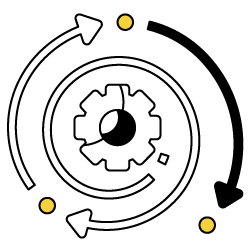A high-performing search engine optimization (SEO) strategy takes a multipronged approach to help your site consistently rank well in search engine results pages (SERPs). Page categories represent an often overlooked part of an SEO plan. Here’s how they can affect your ranking and what you can do to enhance them.
What are page categories?
Page categories are essential parts of a site’s structure or taxonomy. They use keywords to organize content, help users navigate it, and assist search engine crawlers in detecting your site’s purpose.
Consider a meal kit delivery service. It may have “Plant-Based Options,” “Family Favorites,” “Meals For One,” “Gluten-Free Dishes,” and “High-Protein Choices” as page categories. You can use keywords in page titles and URLs to support SEO best practices.
Page categories also often have parent-child hierarchies or top-level pages and subcategories. If “Plant-Based Options” was the parent category, there could be child categories such as “Ready In Less Than 30 Minutes,” “Low-Sodium Dishes,” and “Reduced-Fat Entrees.”
[Case Study] Increase crawl budget on strategic pages
How do page categories affect SEO rankings?
Marketers and SEO specialists understandably consider Google the authority for all ranking best practices. John Mueller is a senior webmaster trends analyst at the company. During an extensive 2020 discussion, he brought up site structure several times while answering questions from participants. Here’s how he and others connect page categories to SEO success.
Flat site structures pose preventable problems
Mueller clarified that ideal site structures let crawlers move from one page to another with on-page URLs. If all site pages are only one click away from the home page, that results in a flat site structure that interferes with crawlability.
Conversely, page categories support deep site structures that help search engine crawlers correctly classify page content.
Category pages give helpful context
Mueller also mentioned that if Google’s crawlers only see URLs through a sitemap file, there’s a lot of lost context that would otherwise show how pages relate to each other. That makes sense because Google rankings reward relevancy. If it’s difficult to confirm a page’s relevance to your overall site, it may not rank as well as it could.
Well-organized category pages increase dwell time
If you take the time to organize your category pages thoughtfully and create descriptive titles for each one, those measures could raise your site’s dwell time. This metric represents how long people spend on your site before returning to the SERPs. Dwell time goes up when visitors find useful information. SEO experts have split opinions on whether Google considers dwell time an official ranking signal.
However, the company does reward high-quality, authoritative content. If you have it on your site, dwell time should naturally Increase. People will realize that it’s worthwhile to stay where they are to find information rather than looking elsewhere. Moreover, category pages guide how they use your site, making it easier to find the information that matters to them.
Category pages drive more traffic to e-commerce sites
Research presented at the SMX West 2020 SEO conference by Jill Kocher Brown concerned 30 top e-commerce sites and rankings for 25 billion keywords. The goal was to see if product or category pages performed better in SEO rankings.
The results showed that category pages outperformed at 27 of the 30 sites examined. They received a whopping 413% more traffic and had 19% more ranking keywords than product pages.
Category pages can showcase unique content
Google’s experts also advise people to avoid including duplicate content on their sites. The company’s representatives know that it may appear on a site for malicious reasons, such as to boost a site’s rankings artificially. Then, offending sites may receive penalties.
A common category page mistake is to include boilerplate text on each one. However, you must avoid such unoriginality. One easy way to show Google’s crawlers that you have unique content is to write category descriptions for each page. Besides helping your SEO rankings, this practice also makes your site more valuable for users.
How canyou optimize page categories?
Making category page optimization pay off requires following a thoughtful strategy and taking advice from experts. Here are some practical ways to start.
Stay consistent and consider using multiple headings
After presenting her research to peers, Jill Kocher Brown offered some tips for people who want to focus on category page optimization. One of her suggestions was to use templates for consistency, but avoid over-optimizing them with too many links or keywords.
She also recommended removing unnecessary words in headers. For example, instead of having a category page saying, “Search Results: Women’s Shoes,” change it to “Women’s Shoes” to benefit from a quick optimization trick.
Think about ways to optimize headings lower down on the page, making them support your category, too. For example, you could display complementary products under a section that says “People Who Purchased [Product Category] Also Loved,” or “Products Related to [Product Category].” This approach helps site visitors and search crawlers correctly view your site in context.
Make your page category content maximally informative
You may wonder if there’s an optimal number of categories for your site to have. Experts suggest you should aim for roughly five to seven categories, and be sure to give them descriptive names.
It also helps to stick with an identifiable theme when possible. For example, you could create categories for each industry your company serves. Doing that conveys authority and quickly provides information that gives relevance. You might also wish to have a parent category called “Industries,” with child categories for each sector.
Picking an appropriate number of categories also helps people get orientated when arriving at your site. Don’t forget to write category descriptions that give viewers a preview of what to expect. You can even insert a link or two in a description to take people to related content. That could help them find the content they need faster.
Use descriptive and dedicated category names
You’ve probably heard that one of the best ways to rank well is to provide content that helps users. Google prioritizes excellent user experiences, so keeping your audience in mind improves SEO outcomes.
Optimizing your category pages may mean going back and removing or renaming categories that are too similar to existing ones. For example, many blogs group content into categories. People can click on one to see all posts related to a specific subject.
However, it becomes confusing when you have similar categories on the same site. Maybe your pet store has “Dog Training” and “Dog Education” categories. People will have trouble determining the difference between those. Plus, this problem could also cause duplicate content if you feature the same products or information in both. Take the time to go through all your categories to see if you should rename or delete some for clarity.
How can you track page category performance?
Using page categories to boost your SEO ranking is not a quick fix. John Mueller even recommended using visual indicators to show people who land on product pages that you have category pages they may find useful. For example, you could have a small graphic or banner they can click on to see the category page. That helps ensure the right page ranks while you look deeper into improving it.
Start by analyzing your internal linking structure. From the Google Search Console, choose Search Traffic, then Internal Links. Hopefully, the pages at the top of the list are those you want to show up in the SERPs. You can use tools that mimic how bots crawl your site, as well.
Also, there are Crawl Stats accessible through the Google Search Console. That data shows you what Google’s bots found when crawling your site and whether they encountered any problems. Review those details and fix any identified issues — whether or not they relate to page categories. You can then request that Google recrawl your page. That’s a good thing to do after making extensive changes, especially since the crawlers notice new material.
It’s also smart to look at metrics that help show whether people find the site valuable, such as dwell time and bounce rate. The longer people spend on a website, the better the chance it means they’ve found what they needed. Moreover, as you’ve learned earlier, page categories can help influence a user’s satisfaction with a site. Thus, they may linger longer when you have relevant category pages for them to explore.
Finally, look at the page categories and associated content for sites that rank better than yours. What do those sites do better, and how could you adopt some of the same techniques?
Page categories support SEO success
Think of page categories as essential aspects for better rankings. They’re not the only influential factors, but this guide will help you make worthwhile changes. They’ll help a site appear higher in the SERPs, plus show visitors that you have a helpful and informative online destination.

